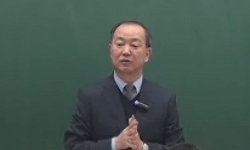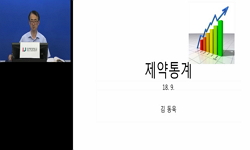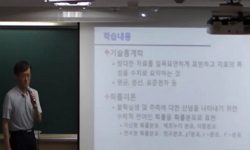The 13 acoustic parameters analyzed in this study were voice onset time (VOT); four kinds of moment parameters, namely center of gravity, standard deviation, skewness, and kurtosis, related to the spectral energy distribution of initial 5ms release bu...
http://chineseinput.net/에서 pinyin(병음)방식으로 중국어를 변환할 수 있습니다.
변환된 중국어를 복사하여 사용하시면 됩니다.
- 中文 을 입력하시려면 zhongwen을 입력하시고 space를누르시면됩니다.
- 北京 을 입력하시려면 beijing을 입력하시고 space를 누르시면 됩니다.

한국어 파열음 조음자리와 발성유형 구분을 위한 음향변수 분석 및 선정 = Analysis and Selection of Acoustic Parameters for Classifying Places of Articulation and Phonation Types of Korean Plosive Sounds
한글로보기https://www.riss.kr/link?id=A108280400
- 저자
- 발행기관
- 학술지명
- 권호사항
-
발행연도
2022
-
작성언어
Korean
- 주제어
-
등재정보
KCI등재
-
자료형태
학술저널
- 발행기관 URL
-
수록면
571-610(40쪽)
- DOI식별코드
- 제공처
- 소장기관
-
0
상세조회 -
0
다운로드
부가정보
다국어 초록 (Multilingual Abstract)
The 13 acoustic parameters analyzed in this study were voice onset time (VOT); four kinds of moment parameters, namely center of gravity, standard deviation, skewness, and kurtosis, related to the spectral energy distribution of initial 5ms release bursts; the total amount of spectral energy; the 4 moment parameters of the 5ms following vowels of CV contexts; and the fundamental frequency, H1-H2 (first harmonic energy subtracted from second one), and H1-A2 (first harmonic energy subtracted from second formant energy) measured in the 50ms following vowels.
These parameters were examined to determine whether they are related to the phonation types and places of articulation of Korean plosive sounds. The parameters’ values were evaluated by linear discriminant analysis, a machine learning method used to classify groups. VOT and H1-H2 contributed the most to phonation type while skewness and center of gravity contributed the most to places of articulation. The classification accuracy using significant acoustic parameters was 91.5% for phonation types and 76.7% for the places of articulation.
국문 초록 (Abstract)
유성 개시 시간(VOT), 개방 파열 부분(5ms)의 스펙트럼 에너지 분포와 관련된 적률변수(moment parameters) 네 가지(무게중심, 표준편차, 왜도, 첨도) 스펙트럼 에너지 총량, 파열음 후행 모음 5ms 구간...
유성 개시 시간(VOT), 개방 파열 부분(5ms)의 스펙트럼 에너지 분포와 관련된 적률변수(moment parameters) 네 가지(무게중심, 표준편차, 왜도, 첨도) 스펙트럼 에너지 총량, 파열음 후행 모음 5ms 구간의 적률변수 네 가지와 파열음 후행 모음 50ms 구간에서 측정한 기본 주파수, H1-H2, 그리고 H1-A2를 주요 음향변수로 설정하여 이들이 한국어 파열음의 발성유형 및 조음자리와 관련하여 유의한 변수인지 살펴보았다. 유의한 음향변수로 확인된 경우 집단 분류에 활용하는 기계학습 방법인 선형 판별 분석을 이용하여 변수의 가치, 기여도까지 평가해보았다. 발성유형과 관련해서는 유성 개시 시간과 H1-H2가 가장 주요하게 기여하였으며 조음자리 구분과 관련해서는 개방 파열 구간의 적률변수 중 왜도와 무게중심의 기여도가 가장 컸다. 유의 음향변수들을 이용한 분류 정확도(classification accuracy)는 발성유형의 경우 91.5%, 조음자리의 경우는 76.7%로 나타났다.
1 정윤자, "후행모음의 피치를 고려한 한국어 평음, 경음, 격음의 인지 실험" 우리말학회 (27) : 73-94, 2010
2 김지은, "한국어 폐쇄음 발음과 최근의 발음 변이: 발화 형태별 VOT와 f0를 중심으로" 한국음성학회 9 (9): 41-47, 2017
3 표화영, "한국어 파열자음의 인두내압, 폐쇄기 및 Voice Onset Time (VOT)에 관한 실험적 연구" 대한후두음성언어의학회 10 (10): 50-57, 1999
4 이경희, "한국어 파열음의 음향적 특성과 지각 단서" 한국음성과학회 7 (7): 139-155, 2000
5 박한상, "한국어 자음군의 후행모음에 나타난 발성유형의 음향음성학적 연구" 대한음성학회 1 (1): 53-76, 2007
6 성철재, "충남지역 대학생들의 한국어 단모음 포먼트 분석" 사단법인 한국언어학회 (43) : 189-213, 2005
7 장우혁 ; 김길동, "중국어 화자가 발음한 한국어 파열음의 음향적 특성" 언어정보연구소 26 (26): 91-109, 2009
8 배재연, "음성 환경에 따른 한국어 폐쇄음의 음향적 특성" 한국음성과학회 5 (5): 139-159, 1999
9 이슬기 ; 이영미, "연령에 따른 VCV 문맥에서 한국어 폐쇄음의 성대진동개시시간" 한국음성학회 7 (7): 37-44, 2015
10 최은아 ; 박한상 ; 성철재, "심도 청각장애 아동의 음질 특성: H1-H2와 스펙트럼 기울기를 중심으로" 사단법인 한국언어학회 (70) : 3-17, 2014
1 정윤자, "후행모음의 피치를 고려한 한국어 평음, 경음, 격음의 인지 실험" 우리말학회 (27) : 73-94, 2010
2 김지은, "한국어 폐쇄음 발음과 최근의 발음 변이: 발화 형태별 VOT와 f0를 중심으로" 한국음성학회 9 (9): 41-47, 2017
3 표화영, "한국어 파열자음의 인두내압, 폐쇄기 및 Voice Onset Time (VOT)에 관한 실험적 연구" 대한후두음성언어의학회 10 (10): 50-57, 1999
4 이경희, "한국어 파열음의 음향적 특성과 지각 단서" 한국음성과학회 7 (7): 139-155, 2000
5 박한상, "한국어 자음군의 후행모음에 나타난 발성유형의 음향음성학적 연구" 대한음성학회 1 (1): 53-76, 2007
6 성철재, "충남지역 대학생들의 한국어 단모음 포먼트 분석" 사단법인 한국언어학회 (43) : 189-213, 2005
7 장우혁 ; 김길동, "중국어 화자가 발음한 한국어 파열음의 음향적 특성" 언어정보연구소 26 (26): 91-109, 2009
8 배재연, "음성 환경에 따른 한국어 폐쇄음의 음향적 특성" 한국음성과학회 5 (5): 139-159, 1999
9 이슬기 ; 이영미, "연령에 따른 VCV 문맥에서 한국어 폐쇄음의 성대진동개시시간" 한국음성학회 7 (7): 37-44, 2015
10 최은아 ; 박한상 ; 성철재, "심도 청각장애 아동의 음질 특성: H1-H2와 스펙트럼 기울기를 중심으로" 사단법인 한국언어학회 (70) : 3-17, 2014
11 윤규철, "서울 코퍼스의 한국어 파열음 연구" 언어정보연구원 50 : 479-501, 2020
12 정윤자 ; 이재춘, "몽골어 화자를 대상으로 한 한국어 폐쇄음의 음향적 특성 연구" 어문연구학회 65 : 103-124, 2010
13 손형숙 ; 안미애, "단어 내 위치에 따른 한국어 폐쇄음의 VOT 연구: 대구지역어 화자를 대상으로" 언어과학회 (59) : 149-180, 2011
14 임신영, "경상 방언 화자의 운율경계에 위치한 한국어와 영어의 어두폐쇄음 비교 —VOT, F0와 [H1-H2]의 음향적 상관성을 중심으로" 21세기영어영문학회 29 (29): 173-196, 2016
15 박한상, "개방 파열의 스펙트럼상의 특성" 대한음성학회 159-162, 2003
16 Ladefoged, P, "Vocal fold physiology: contemporary research and clinical issues" College Hill Press 351-360, 1983
17 Stevens, K., "Vocal fold physiology: Voice quality control" Singular 147-170, 1995
18 Blankenship, B, "The timing of nonmodal phonation in vowels" 30 (30): 163-191, 2002
19 Silva, D. J, "The phonetics and phonology of stop lenition in Korean" Cornell University 1992
20 Han, J, "The Phonetics and Phonology of tense and plain consonants in Korean" Cornell University 1996
21 Park, H, "Temporal and spectral characteristics of Korean phonation types" The University of Texas at Austin 2002
22 Forrest, K., "Statistical analysis of word-initial voiceless obstruents: Preliminary data" 84 : 115-123, 1988
23 황현경, "Spectral Characteristics of Frication Noise in Korean Sibilants" 대한음성학회 0 (0): 31-50, 2004
24 성태제, "SPSS/ AMOS를 이용한 알기 쉬운 통계분석" 학지사 2011
25 Wells, J., "Practical phonetics" Pitman publishing 1971
26 Ahn, H., "Post-release phonatory processes in English and Korean" The University of Texas at Austin 1999
27 Broersma, M., "Korean lenis, fortis, and aspirated stops: Effect of place of articulation on acoustic realization" 941-944, 2010
28 Lindblom, B., "Dissecting coarticulation: How locus equations happen" 40 : 1-19, 2012
29 McLachlan, G, "Discriminant analysis and statistical pattern recognition" Wiley-Interscience 2004
30 Kang, K., "Clear speech production of Korean stops: Changing phonetic targets and enhancement strategies" 124 (124): 3909-3917, 2008
31 Klatt, D., "Analysis, synthesis, and perception of voice quality variations among female and male talkers" 87 (87): 820-857, 1990
32 Stevens, K. N, "Acoustic phonetics" MIT Press 1999
33 Silva, D, "Acoustic evidence for the emergence of tonal contrast in contemporary Korean" 23 : 287-308, 2006
34 Jongman, A., "Acoustic characteristics of English fricatives" 108 (108): 1252-1263, 2000
35 Johnson, K, "Acoustic and auditory Phonetics" Oxford 2003
36 Cho, T., "Acoustic and aerodynamic correlates of Korean stops and fricatives" 30 : 193-228, 2002
37 Kent, R., "Acoustic analysis of speech" Delmar 2007
38 한정임, "A developmental study of Korean stop production by Chinese learners" 한국음성학회 138-139, 2011
39 Lisker, L., "A cross-language study of voicing in initial stops: acoustical measurements" 20 (20): 384-422, 1964
동일학술지(권/호) 다른 논문
-
- 한글학회
- 권성미
- 2022
- KCI등재
-
동부 경남 방언권역의 부산 방언 분화 연구—어휘를 중심으로—
- 한글학회
- 이근열
- 2022
- KCI등재
-
박중화의 한·일 학습서에 나타난 문법 기술 고찰—문자와 발음 및 음운 현상을 중심으로—
- 한글학회
- 주현희
- 2022
- KCI등재
-
- 한글학회
- 임지룡
- 2022
- KCI등재




 DBpia
DBpia






